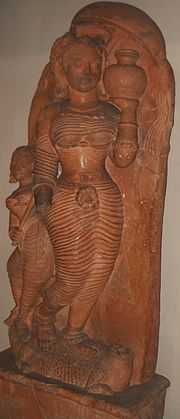Kumbha

The Kumbha (Sanskrit: कुम्भ), is a full vase, pot, a jar or a pitcher. In the context of Hinduism and Hindu mythology, it is also symbolic of the womb. It represents fertility, life, generative power of human beings and sustenance; and is generally associated with the mother goddesses, particularly Ganga.[1]
In Hindu mythology and scriptures, several references are found of human beings born from Kumbha. A legend states that rishi Agastya was born out of a womb.
In several religious ceremonies and rituals, Kumbhas (pots) or Kalasha filled with water and leaves and decorated with intricate motifs, sometimes with ornaments, play an important role in ancient India. These rituals still survive in India.
In Indian Astrology (Jyotisa), Kumbha also stands for the zodiac sign Aquarius, and is also associated with the Kumbha Mela, which happens when planet Brihaspati moves into the sign.
In Hindu epic Ramayana, Ravana's brother Kumbhakarna had a son named Kumbha.
See also
- Bumpa
- Kumbh Mela
- Jyotiṣa - Indian Astrology
Notes
- ↑ Darian 2001, p. 125 Quote: The Kumbha: After the Makara, Ganga's most distinctive sculptural feature is the full vase, first appearing with the river goddess on the same Varaha cave frieze from Udaygiri. Although not common in the early stages of the Ganga image, the full vase appears more and more frequently as the Ganga theme reaches maturity.
References
- Darian, Steven (2001), The Ganges in myth and history, Delhi:Motilal Banarasidass. Pp. xviii, 219. Originally published in 1978 by The University of Hawaii Press, Honolulu., ISBN 81-208-1757-5
- Dictionary of Hindu Lore and Legend (ISBN 0-500-51088-1) by Anna Dallapiccola
| |||||||||||||||||
